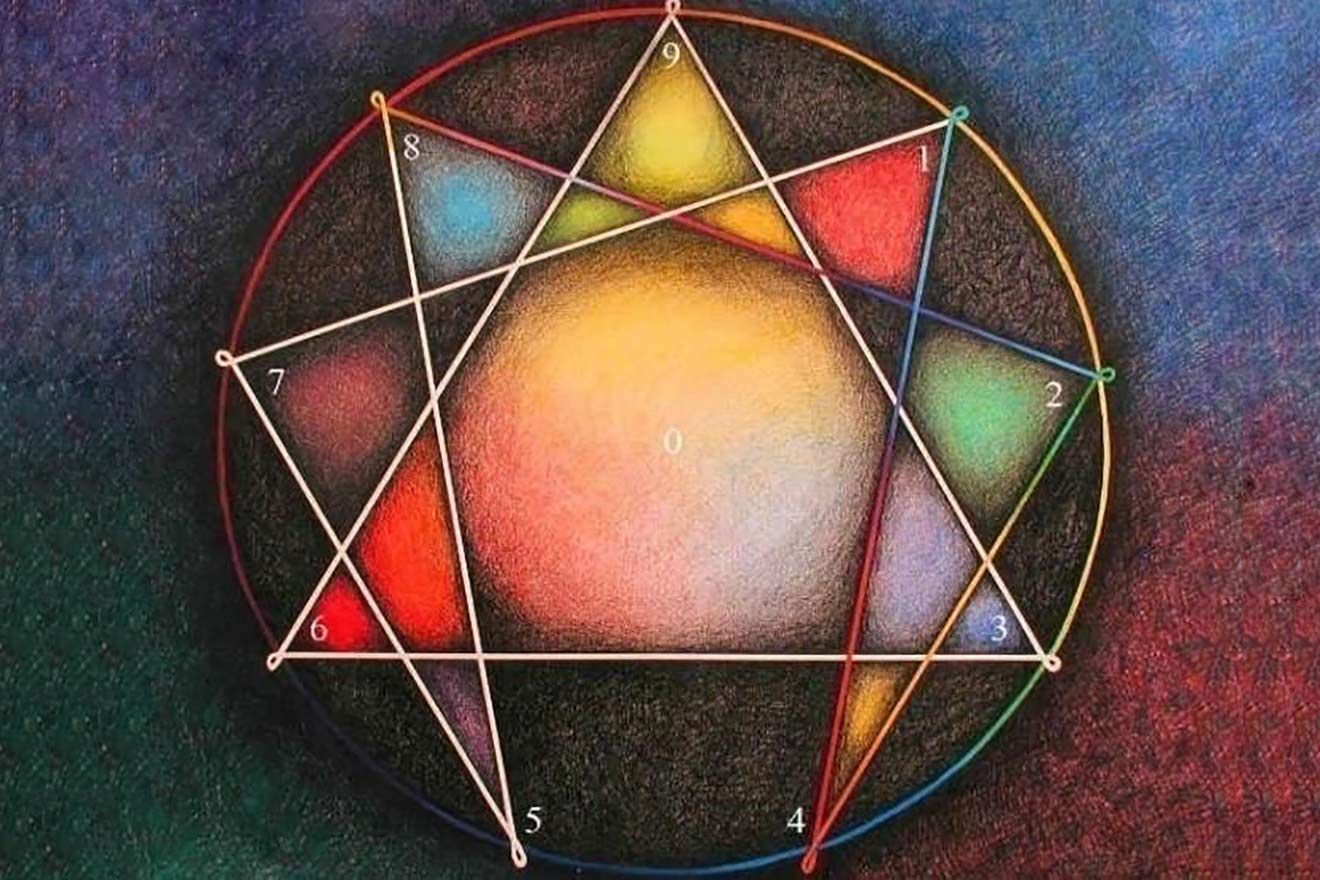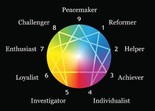Psychedelics can be a tool for inner exploration, yet often there are questions on how to get the most out of these experiences. Join Mollie M. Pleet, PsyD and Anthony C. Graffagnino, MDiv as they invite us to see how the personal exploration tool of the Enneagram may be a useful map to inform our psychedelic journey.
The beauty and plight of psychedelic journeying
“What is above knows what is below, but what is below does not know what is above. One climbs, one sees. One descends, one sees no longer, but one has seen.”
– Rene Daumal
Like an ascent to the peak of a high mountain, psychedelic journeys can provide us glimpses into the wider terrain of our lives. They can bring our pasts into the present and allow what is within us to appear in the forefront. Whether through direct insight, emotional release, or the projection of colorful illusions, these mind-expanding medicines can reveal the brightest facets of our identities, as well as those parts in need of healing. We transcend, we explore, we traverse the expansiveness of the mystical universe. Then, we climb back down.
That we consistently return from psychedelic journeys does not negate their therapeutic potentials. The feelings of awe, experiences of insight, and awareness of the ineffable can be deeply medicinal. However, our capacities to shift our lives according to these entheogen-infused wisdoms depend heavily on our ability to both navigate the psychedelic terrain and integrate its features into our daily lives. So, how do we ensure the appropriate structure and support for this integration? How can we make sense of challenging, confusing, or bizarre psychedelic content? And, more importantly, how can we retain the deeply sensed but often inexpressible knowing that all people, though seemingly distinct, represent facets of a unified and perfect whole? To help address these questions, we look to the Enneagram.
Follow your Curiosity
Sign up to receive our free psychedelic courses, 45 page eBook, and special offers delivered to your inbox.The Enneagram
The Enneagram is a tool for personal and collective development designed to guide us on a healing pathway toward our most vibrant and balanced selves. Its basic premise is that while we may easily recognize what we are doing day-to-day, rarely do we connect with the deepest why behind our actions. The Enneagram not only unearths our unconscious motivations; it also reveals strategies to improve our self-awareness, communication, and relationships with self, others, and the world. Though its lineage is ancient, in its modern usage it can be understood as a map of psychospiritual development, revealing the roads, alleyways, and tunnels from our self-protecting–yet also self-limiting–ego structures towards greater health and wholeness.
George Gurdjieff (1866/1877-1949), a Greek-Armenian wisdom seeker whose teachings helped popularize the modern Enneagram, proposed that each human is an individual “spark of the Divine” born a composite of nine archetypal personalities through which the energy of life flows like electricity through a circuit (Riso & Hudson, 1999). Then, through birth and early childhood conditioning, a kink forms in the circuitry where energy tends to pool. This kink develops in response to an environment that does not immediately address our every need. In order to get our basic needs and desires met, we develop patterns of behaving that follow one of nine basic personality formations. Over time, these energy formations become our ingrained personality constructs, or what here we call our Enneatypes.
Getting Started
Each one of the nine points on the Enneagram symbol corresponds to one of the nine basic Enneatypes (Daniels & Price, 2009). Per Enneagram theory, the initial step in the self-discovery process is to identify the Enneatype that best reflects our inner life. Though a thorough explanation of type identification is beyond the scope of this article, many wonderful resources (apps, quizzes, readings, etc.) exist to support this learning (see end of article for guidance).
Once we locate our Enneatype (see Table 1 for brief descriptions), we begin exploring the trails that lead to various surrounding points. We learn about our “wings,” or the types neighboring ours. We traverse the symbol’s lines to our two connecting “stress” and “security” points. We tunnel deeper into our primary type to explore the ways our survival, belonging, and bonding instincts create distinct “subtypes” within our primary personality (Chestnut, 2013). Though the Enneagram is defined by its main thoroughfares, zooming in reveals innumerable footpaths connecting each point and region which, when traveled, help us explore ever more facets of ourselves. The more we explore, the more we begin to understand the deeply rooted intentions guiding our attitudes and behavior. We become more supple, more vital, and more responsive to the ever changing present. In so doing, we move away from our fixed ego point and closer toward the center.
The center of the Enneagram appears to be empty. It is, in fact, full. Among the most important functions of the Enneagram is its ability to lead us toward this central mystery–a space where intersecting energies peak and transcendence may be experienced. Here, the limited sense of “I”, along with linear time and materialistic notions of reality, tend to soften. Here, there is space for profound creativity, meaning, and wonder. Here, we may recognize that we are inherently whole and interconnected beings, simultaneously one of nine as well as nine in one. Though we do not dwell here permanently, entering this space is our ultimate objective, in which the majesty of nature is revealed.
Table 1. Enneatype Descriptions
| TYPE | CHARACTERISTICS | BASIC FEAR | ADAPTIVE STRATEGY |
| Type 1: The Reformer | Rational, practical, idealistic, perfectionistic | Being bad, corrupt, evil, or defective | Gain respectability by being good, responsible, conscientious, and meeting high internal standards |
| Type 2: The Giver | Caring, self-sacrificing, helpful | Being unwanted, unloved | Gain love by being pleasing and becoming indispensable within relationships |
| Type 3: The Performer | Excelling, pragmatic, image-conscious | Being worthless or without personal value | Gain approval by being successful, hardworking, and maintaining a good image |
| Type 4: The Romantic | Self-aware, sensitive, sensual, dramatic | Being without identity or significance | Gain admiration by being unique, special, creative, and emotionally deep |
| Type 5: The Investigator | Innovative, cerebral, secretive, isolated | Being useless, incapable, or incompetent | Gain protection by being private, self-sufficient, knowledgeable, and innovative |
| Type 6: The Loyalist | Committed, responsible, security oriented, skeptical | Being unsupported or unprotected | Gain safety by being loyal to friends, suspicious of foes, and maintaining awareness of authority |
| Type 7: The Enthusiast | Spontaneous, scattered, versatile, optimistic | Being stuck, deprived, or in pain | Gain liberation by being adventurous, upbeat, and by seeking as much pleasure as possible |
| Type 8: The Protector | Self-confident, protective, decisive, domineering | Being harmed or overpowered | Gain empowerment by being strong, assertive, and by hiding vulnerabilities |
| Type 9: The Peacemaker | Agreeable, self-effacing, complacent | Being lost or separated | Gain peace by being easy going, harmonious, and by avoiding confrontation |
The Enneagram as a Roadmap
There is an art of conducting oneself in the lower regions by the memory of what one saw higher up. When one can no longer see, one can at least still know.”
– Rene Daumal
Psychedelic journeys are famed for their emotionally profound, nonlinear, and occasionally dreamlike features. While this content can be difficult to confront and navigate in real time, making sense of and integrating it afterwards presents additional challenges. The current era of psychedelic medicine encourages thorough preparation and structured integration. Of additional benefit may be using the Enneagram as a map. Following its “roadways” to support our trek to internal regions, the Enneagram process aligns synergistically with the psychedelic journey and may be the appropriate guide for such an endeavor.
What follows is a list of some suggested ways we may use the Enneagram process to prepare for, navigate, and return from psychedelic spaces.
Before We Depart
- Begin by identifying your Enneatype. You may do this by taking any of a number of online self-tests, or by simply learning about the nine types and deciding which one best aligns with your experience.
- *Please note: Enneatype identification is a journey of self-discovery that may take longer for some people than for others. Be gentle with yourself if you have trouble identifying your type. Recall that there is healing in the self-exploration, and that every introspection brings you closer to yourself.
- Study the three “intelligence triads” (head, heart, body) and engage in preparatory practices to create balance among the triads. For example, if your Enneatype resides in the head (thinking) triad, you might engage the body (sensing) triad through mindful physical activity and the heart (feeling) triad through self-compassion meditation. If you are not sure of your primary type, engage in activities that honor each of the triads in turn.
- Reflect on the themes of your Enneatype and use them to develop journey intentions. For some, intentions may be as simple as, “follow the medicine” or “stay with what arises.” For others, intentions may target more specific themes and areas.
During the Journey
- Notice how thoughts, emotions, and sensations from your three intelligence triads present themselves. Pay attention to which triad(s) speaks louder, and which one(s) may be less vocal. Experiment with listening to the one(s) that may be faintest, inviting the full expression of each triad to bear on your awareness.
- Follow the “security arrow” from your primary type to your “security point.” During your journey, use the themes of your security point to bring awareness and self-compassion to core developmental wounds that may surface.
- Follow the “stress arrow” from your primary type to your “stress point.” If the energy from your stress point arises, notice what need may be connected to it, and move to address that need appropriately.
Returning Home
- Bolster your “self-preservation” instinct by using the Enneagram as a template to create a visual map of your psyche. Illustrate the insights and archetypal energies from your journey by labeling them (through words, doodles, colors, etc.) with the Enneatypes they represent. Get creative! This will help integrate less centralized aspects of your identity into a more vital and expansive YOU.
- Bolster your “bonding” instinct by bringing to awareness interpersonal insights from your journey. Ask yourself—How did shame, fear, or anger show up in me? What roles do shame, fear, or anger play in my relationships with others? Use the three “triads” to increase compassion for these experiences in yourself and other people.
- Bolster your “social” instinct by revisiting your journey. In what ways did you experience a sense of unity or connection (with people, nature, the cosmos, etc.)? Within how many different systems can you claim belonging? Draw on the strengths and growth edges of your Enneatype to sustain and celebrate your innate connectedness.
We journey to the inner mountain, because it is our ancestral land. We go up the mountain, not to live there, but to remember that it, too, is our home. With each journey up the mountain, we are given a chance to fill in more of the map of our lives. And when we come back down, we have our map to help us remember. This map, the Enneagram, contains the depth and expansiveness to function synergistically with psychedelic journeys. With the tools to explore further into our inner landscapes, we gain the awareness to support ourselves—and others—more compassionately. The more we understand our unique features, the more we appreciate how our diversity serves the collective. We learn that, though we may walk differently, we always walk together.
References:
- Chestnut, B. (2013). The complete enneagram: 27 paths to greater self-knowledge. She Writes Press.
- Daniels, D. & Price, V. (2009). The essential enneagram: the definitive personality test and self-discovery guide. HarperOne.
- Riso, D. R., & Hudson, R. (1999). The wisdom of the Enneagram: The complete guide to psychological and spiritual growth for the nine personality types. Bantam Books.
Resources for Self-Typing:








